ZUIKO 21mm f/2.0 & 21mm f/3.5 ultra-wideangle lenses
Interesting enough, Olympus ZUIKO lense family, along with Leica's Leitz are the only two major 35mm SLR manufacturers that are still offering ultra-wideangle lenses with a specific 21mm focal length. On the other hand, Zeiss, selling via Contax range of SLRs has strangely omitted the 21mm focal length between Distagon T* 18mm f/4.0 to Distagon T* 25mm f/2.8 and it took Contax almost a decade a Distagon T* 21mm f/2.8 was introduced to patch the missing link in the focal length. Leica had a very early but discontinued Super Angulon 21mm f/4.0 in R-mount, developed in cooperation with Messrs.Jos.Schneider of Kreuzbach - and it remains as the sole 21mm Leica ultrawide lense*. Currently, the nearest equivalent is a 19mm f/2.8 Elmarit-R ultrawide. Credit: Mr. Jan <janm_67@hotmail.com> for rectified a mistake made in this page.
Next interesting issue is, Olympus offers not one but two lenses at this specific wide vision focal length. Along with a high speed Zuiko 21mm f/2.0, there is also an alternative compact Zuiko 21mm f/3.5 lense for sonsideration. The 21mm f/2.0 still holds the honour of being first ultrawide in the world with a super bright f/2.0 maximum aperture among all 35mm camera/lense manufacturers that provide ultrawideangle lenses between 19mm to 21mm**. Strangthly to note, despite Olympus had started early offering an f/3.5 Zuiko ultrawide but they decided to by-pass a possible f/2.8 lense version and went straight up for a double f-stops speed gain to a f/2.0 lense.
 |
* Leica does have a few alternatives in this particular focal length BUT only available for the Leica M-mount rangefinder cameras, a 21mm f/2.8 Elmarit, including an old 21mm f/4.0 Super Angulon in M-mount. Even the Nikon also has produced a version of Nikkor 21mm f/4.0 which required an external attachment finder for focus and picture composing. |
Zuiko 21mm f/2.0 ultra-wideangle lense
This remarkable ZUIKO ultrawide comes with an amazing super bright f/2.0 aperture,
which makes focusing, picture composing and low-light photography exceptionally easy.
Yet despite its extraordinary lense speed with high resolving power, it weighs merely
250 grams ! This Zuiko classic has remained as one of the status lense for Olympus
all these years and easily one of the main attraction that can pull your heartstrings
to have a good look into the OM system...
Generally, lenses at this focal length is an very interesting and often underrated by many photographers mainly due to its first exaggeration of perspective as compared with the common wide angle vision of 24mm, 28mm or 35mm. Honestly, most people would regard the 24mm as ultrawide as well, but the 21mm ultrawide is perhaps the first lense that actually portrays a feel of the exciting world of ultra-wideangle photography.
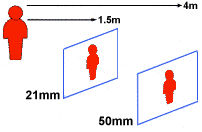 |
The angle of view of a 50mm lens is 46°. Thus, the angle of view of the 21mm (92°) is just about double. What is most important is that the 21mm takes in about four times the picture area. The easiest way to understand this is to look in a viewfinder, first with a 50mm lens and then with a 21mm. For example, if you stood about 4 meters from a subject using a 50mm lense, you would record the same size image as at 1.5 meters with a 21mm lens. With a 18mm lens you could shoot as close as approx. 1 meter to record an image the same size as the one recorded with the 50mm lense. |
 |
Hay bales, Shropshire |
With an ingenious optical design that comprises of a 11 elements in 9 group formula and despite comews with a fast lens speed with other strong features as an ultra-wideangle, this ZUIKO 21mm was considerably compact and light weight which enables utmost portability. Combining a slightly a more gentle picture angle than the 18mm Zuiko counterpart and almost two full f-stops faster in maximum aperture, the Zuiko 21mm f/2.0 can be a perfect solution for shooting in tight quarters under poor available light conditions. Its fast f/2.0 maximum aperture makes viewing and focusing much easier than with other slower speed lenses. With seven settings in its aperture range from f/16-f/2.0, there is a great deal for photographers to be able to manipulate creative depth of field control - although personally, I would like to see the minimum aperture be able to stop down further to a smaller f/22 but the nature of extended DOF in any ultra-wideangle should compensate such short fall. Anyway, during shooting, one may also use the extended depth-of-field nature inherent in this ultra-wide lense for shooting scenes that may require high shutter speeds but requires vast amount of zone of sharpness For example, by setting the lens distance scale at 10 feet, everything from about five feet to infinity should look relatively sharp on film. This means that precise focusing is not always imperative, making this lens is particularly helpful when there's little time to focus, such as when photographing scenes that require a photographer to react quickly. The main strength of this Zuiko lense is its maximum lens speed where it holds an distinctive advantage for indoor, stage and available light photography such as commercial, news, reportage, sports, journalism, travel, available light portraiture and industrial works.
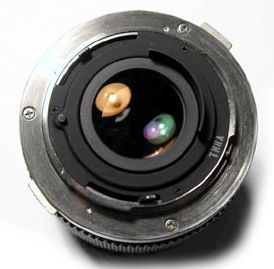 |
 |
<<< -- Credit: Images courtesy of Mr. Steve <smurfbike@hotmail.com>. website: smurfbike.com® Image copyright © 2003. All rights reserved. Please respect the visual property of the contributing photographer. If you intend to use this image for other purpose, a written permission from the creator is always encouraged. |
Another highlight of this superbly crafted Zuiko lense is, since majority of lenses are designed for optimum performance at infinity; when used at their closest focusing distance, picture quality has a tendency to deteriorate, This is especially true of asymmetrical-type wide-angle lenses. One of the strong points of this high speed 21mm Zuiko lense is, it incorporates a floating element system for improved sharpness from its close 0.2 meter (0.7 ft) minimum focusing distance to infinity and ensuring its superlative optical performance be extended to its closest working range. This lense has received rave reviews for its overall performance, the use of special optical glass with a high refractive index corrects any possible aberrations such as spherical, curvature of field and also astigmatism to absolute minimal level. It is a lense that shines not just in its specification but also performs up to expectation, and it is not unusual why most people have often forgotten within the Zuiko lens family has another more practical G-Zuiko f/3.5 AUTO-W ultrawide with a slower f/3.5 maximum aperture as this lense always command a better reputation than the slower equivalent 21mm ultrawide.
Physically, the lense has a large piece of front lense element dominating the front section, various lense data is imprinted in and around the inside section of the metal filter rim. The built quality is superb with an extended and slip-free diamond edged texture focusing grip for positive focusing action. Depth of field indicators are very well illustrated with various scales in three apertures (f/4.0, f/8.0 and f/16) along with a prominent infrared index provided to easy reference. The rear lens element is quite sizable due to its extra requirement of light gathering power. Overall, its finely crafted top rated physical construction supplements its widely acclaimed optical performance in making this Zuiko classic such a desirable optic to own.
 |
Due to its relatively large aperture, the lense requires a larger attachment size of 55mm. Despite its fast speed and other strong optical features, this lense is highly portable which makes it a clear favourite among photojournalists, just for comparison, despite a f-stop faster - the Zuiko only weighs 250g while a comparing Zeiss Distagon T* 21mm f/2.8 weighs a massive 550g and the Zuiko's length measures only at 44mm (90.5mm for the Zeiss). Impressive huh ? Err .. wait till you read the technical data of a halved in price Zuiko 21mm f/3.5 lense featured below ..... |
Specifications:
Focal length: 21mm
Aperture ratio: 1:2.0
lense construction: 9 groups, 11 elements
Angles of view: Diagonal: 92°
Distance scale: (m) 0.20 to infinity (OO)
Focusing: Straight Helicoid
Minimum and Maximum aperture: f/16 ~ f/2.0
Minimum photographic range: 14cm x 21cm (5.5" x 8.3")
Lens hood: 55mm screw-in
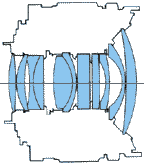 |
 |
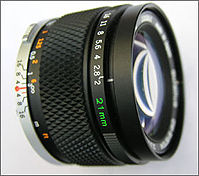 |
Diaphragm: Automatic |
Recommended Focusing
Screens: 1:1*, 1:2**,
1:3*, 1:4*, 1:5#, 1:10*, 1:13*, 1:14*
Recommended
Focusing Screens: 1:1*, 1:2**, 1:3*, 1:4*, 1:5#, 1:10*, 1:13*, 1:14*
*
Compatible.
Focusing and exposure accuracy remains. **
Compatible,
Focusing and exposure accuracy remains intact but microprism, corners of the screen
and split image may darken. # Compatible with OM-1(n)
and Om-2(n), may be used on OM-3(ti) and OM-4(ti) or equivalent, they provide accurate
focusing but exposure error may
occur
in manual mode.## More
info on "Picture Angle" or make use of the Glossary
section in PIM site..
 <<<
-- Credit: Image
courtesy of OM Message Board's co-maintainer Mr. Rick Oleson® <rick_oleson@yahoo.com> Image copyright © 2003. All rights
reserved. <<<
-- Credit: Image
courtesy of OM Message Board's co-maintainer Mr. Rick Oleson® <rick_oleson@yahoo.com> Image copyright © 2003. All rights
reserved. |
Zuiko 21mm f/3.5 |
This Zuiko 21mm lense Is the smallest and lightest in this super wide-angle lense group you can find on the market today. Optically, it consists of 7 elements in 7 groups composition and reputedly be able to deliver unusually high resolving power with excellent contrast even at its full apertures. Even if it doesn't provide a close range optical corrrection mechansihm but for close distance works, the lense still discloses superb portrayal power and resolution and contrast meet impeccable OM standards, for much consideration was taken for compensating aberrations The 92° angle of view is suitable for architectural, interior and creative photography. It is so compact that the lense accepts standard OM's 49mm threaded filters.
Early G Zuiko AUTO-W 21mm f/3.5 and revised version introduced at later stage seemingly share a common optical construction and also weighs almost similarly at 185g (6.5oz) (newer design weighs marginally lighter at 180g (6.3oz) but shares a common body length of only 31mm. Its light weight and compact design and its deep depth of field allows you to shoot without even looking through the finder and enable you to handle many photographic assignments with ease. A slight drawback isperhaps the slightly dim viewfinder image and half darkening of split-image rangefinder it projects but can be well compensated with smart slection of focusing types. Physically, this Zuiko ultrawide has a top rated built quality with all control features well placed and illustrated in relation to their respective functions. The depth of field scales covers three apertures from an extensive f/16, f/8.0 and at its widest aperture of f/3.5. This little Zuiko optical marvel focuses down to 0.2m with its helical focusing and providing photographers who puts mobility, portability and cost on their priority list .
 |
This Zuiko ultrawide used to retail new lense at a street price between USD490.00 - 570-00* (used: mint conditionUSD200.00 - 225-00) while the fast speed Zuiko 21mm f/2.0 is selling almost double between USD950.00~1025-00* (used: mint conditionUSD380.00 - 480-00). Source: * Macbroom's Camera Blue Book by Amherst Media, Inc. |
Supplementary user tips: An old but still very useful technique that most news photographer and photojournalists use with the 21mm lense is, first select the aperture and shutter speed combination that will give good exposure and at the same time prevents the effects of camera shake. The distance setting should provide sufficient depth of field, covering the range over which you expect the action to take place. You can either literally shoot from the hip without raising the camera, or quickly bring the camera to your eye and shoot without focusing. The wide angle of coverage will help overcome lack of precise framing of the shot. This is a technique very often used by seasoned news photographers and a very practical way of using ultrawideangle leense for covering fast pace actions, events or happening close by without having the time to focus and composing shots.
Specifications:
Older Version: G Zuiko AUTO-W
21mm f/3.5
Newer Version: Zuiko 21mm f/3.5
Focal length: 21mm
Aperture ratio: 1:3.5
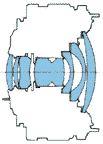 |
 |
Optical construction: 7 groups, 7 elements |
Diaphragm operation: Automatic
Minimum and Maximum aperture: f/16 ~ f/3.5
Minimum photographic range: 14cm x 21cm (5.5" x 8.3")
Filter attachment size/filters: 49mm screw-in
Lens hood: 49mm screw-in
Length: 31mm (1.2")
Maximum Diameter: 59mm (2.3")
Weight: 185g (6.5 oz) (newer version indicates 180g (6.3 oz).
 |
Recommended Focusing Screens: 1:1*, 1:2**, 1:3*, 1:4*, 1:5#, 1:10*, 1:13*, 1:14* * Compatible. Focusing and exposure accuracy remains. ** Compatible, Focusing and exposure accuracy remains intact but microprism, corners of the screen and split image may darken. # Compatible with OM-1(n) and Om-2(n), may be used on OM-3(ti) and OM-4(ti) or equivalent, they provide accurate focusing but exposure error may occur in manual mode.## More info on "Picture Angle" or make use of the Glossary section in PIM site.. |
A Brief
overview on Zuiko Optics
Zuiko Fisheye Lenses 8mm f/2.8 Circular Fisheye | 16mm
f/3.5
Full Frame Fisheye
Zuiko Ultra-Wideangle Lenses 18mm f/3.5 | 21mm f/2.0 | 21mm f/3.5 | 24mm f/2.0 | 24mm f/2.8
Zuiko Wideangle Lenses 28mm f/2.0 | 28mm f/2.8 | 28mm f/3.5 | 35mm f/2 | 35mm f/2.8 |
Zuiko Standard Lenses 40mm f/2.0 | 55mm f/1.2 | 50mm f/1.2 | 50mm f/1.4 | 50mm f/1.8 | Zuiko 50mm f/2.0 PF
Zuiko Medium-Telephoto Lenses 85mm f/2.0 | 100mm f/2.0 | 100mm f/2.8 | 135mm f/2.8 | 135mm f/3.5
Zuiko Telephoto Lenses 180mm f/2.0 EDIF | 180mm f/2.8 | 200mm f/4.0 | 200mm f/5.0 Auto-T (brief)
Zuiko Super-Telephoto Lenses 250mm f/2.0 EDIF | 300mm f/4.5 | 350mm f/2.8 EDIF | 400mm f/6.3
|
500mm | 600mm f/6.5 |1000mm f/11.0
Special application Zuiko optics: 24mm f/3.5 Shift | 35mm f/2.8 Shift | 500mm f/8 Reflex | AF Zoom 35-70mm
f/4.0
| Zuiko
50mm f/2.0 PF
Tele-Converters: 1.4X-A / 2X-A
Zuiko
Macro/Close focus lenses: Zuiko
AUTO MACRO 20mm f/3.5
| Zuiko
AUTO MACRO 20mm f/2.0
| Zuiko
AUTO MACRO 38mm f/3.5
| Zuiko
AUTO MACRO 38mm f/2.8
| Zuiko
AUTO MACRO 50mm f/3.5
| Zuiko
AUTO MACRO 50mm f/2.0
| Zuiko
AUTO MACRO 1:1 80mm f/4.0
| Zuiko
AUTO MACRO 90mm f/2.0
| Zuiko
AUTO MACRO 135mm f/4.5
Zuiko AUTO-Zoom Lenses
- Main
Index page
| S-Zuiko AUTO Zoom 28-48mm f/4.0 | Zuiko AUTO Zoom 35-70mm f/3.6 | S-Zuiko AUTO Zoom 35-70mm f/4.0 | Zuiko AF AUTO Zoom 35-70mm f/4.0 | S-Zuiko AUTO Zoom 35-70mm f/3.5
~ f/4.5
|
S-Zuiko
AUTO Zoom 35-70mm f/3.5 ~ f/4.8
| Zuiko
AUTO Zoom 35-80mm f/2.8 ED
| Zuiko AUTO Zoom 35-105mm f/3.5
~ f/4.5
| Zuiko
AUTO zoom 50-250mm f/5.0
| Zuiko AUTO zoom 65-200mm f/4.0 | S-Zuiko AUTO zoom 70-210mm f/4.5 ~ f/5.6 | Zuiko AUTO Zoom 75-150mm f/4.0 | Zuiko AUTO Zoom 85-200mm f/4.0 |
Zuiko
AUTO Zoom 85-250mm f/5.0
|
S-Zuiko
AUTO Zoom 100-200mm f/5.0
|
| Back | Index Page of OM Zuiko lenses
| Back | to Main Index Page of OM1(n) & OM2(n)
Series SLRs
| Message Board | for
your favourite Olympus
OM-1(n)
and OM-2(n)
series models
| Message Board |
for your
Zuiko Optics in a shared environment
| Message Board | Specifically for Dispose or Looking for OM Photographic
Equipment
About this photographic site.
Home - Photography in Malaysia |
Copyright
© 2000.
leofoo ®. MIR Web Development Team.
Maintainers
for OM Zuiko Site & Message Board:
Rick
Oleson (Email: rick_oleson@yahoo.com Website:
http://rick_oleson.tripod.com), Bruce Hamm
(bhamm@magma.ca), John Orrell
(john@orrellj.freeserve.co.uk), Simon Evans,
(http://www.mawddwy.freeserve.co.uk); Shaun
(shaun@noemail.com), Andy Radcliffe
(AndyJRadcliffe@manx.net)
Special
thanks to:
Gregory
P. Logiodice, Bob Gries, Erwin Voogt, Joel Wilcox, Rick
Oleson, Simon Evan and many others for granting permissions to use their images
of either lenses, cameras and own pictures appeared in this Zuiko website.
Credit: My old time buddy,
Ahmad
Ikram,
Dr of Rubber Research Institute (RRI), Malaysia
who shares the same passion with me and also lending his OM-1n, OM-4 and the Motor
Drive 1 to me for preparing some images in this site; Mark Dapoz <md@dementia.org>for reminding
some broken links; Mr Poon of Foto Poon, Ipoh, Mr Richard, Ampang Park,
Mr Lim and Miss Jenny of Foto Edar for their generosity for
their OM1(n), OM2n camera and some Zuiko lenses. Mr Hans van Veluwen for
mistakenly using some content earlier from his OM website; J Sorensen
for providing some useful images to rectify some technical "flaws"; Mr
Gen Holst for helping during the early stages of development of this OM site;
Mr KKLow for some of his earlier images on the OM-1appeared in this website;
Miss Wati and Mirza for helping me
to convert this Operation Manual into a HTML format. Mr MCLau for rectifying
some mistakes made on the earlier preview sites. A personal tribute to the creator
of the OM system and also a site dedicated to all the fans of Olympuses and Zuiko
Optics worldwide. Some of the content and images appeared in this site were scanned
from OM official marketing leaflets, brochures and instruction manual(s) for educational
purposes. Olympus is a registered trade name of Olympus Optical Inc., Japan. Site
created 'unfortunately again with an IMac.